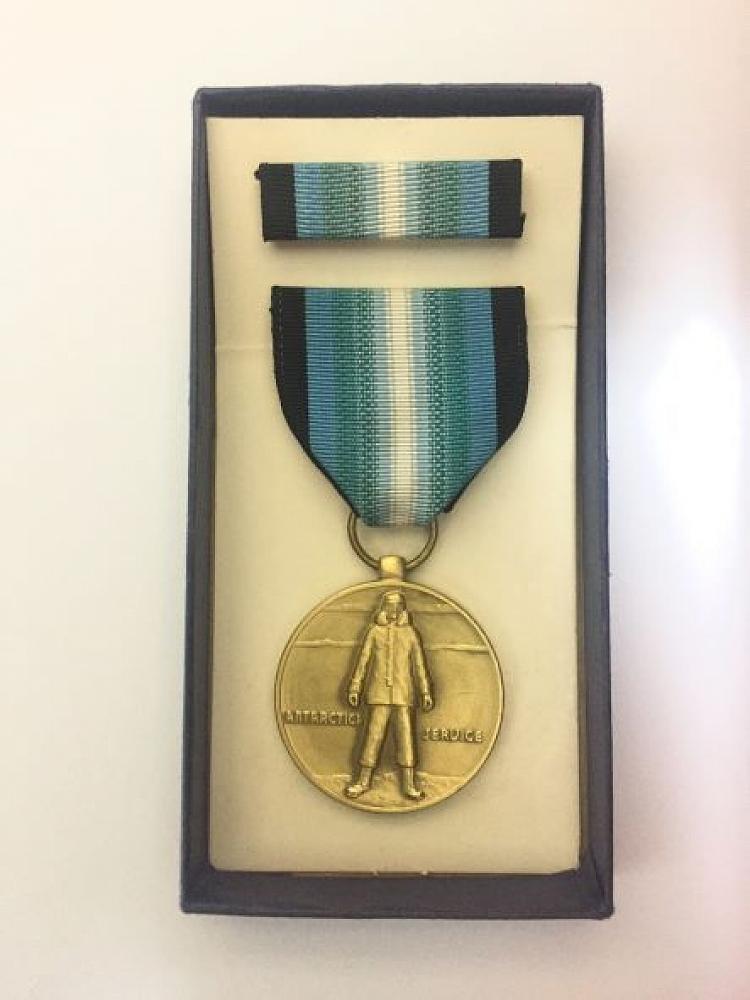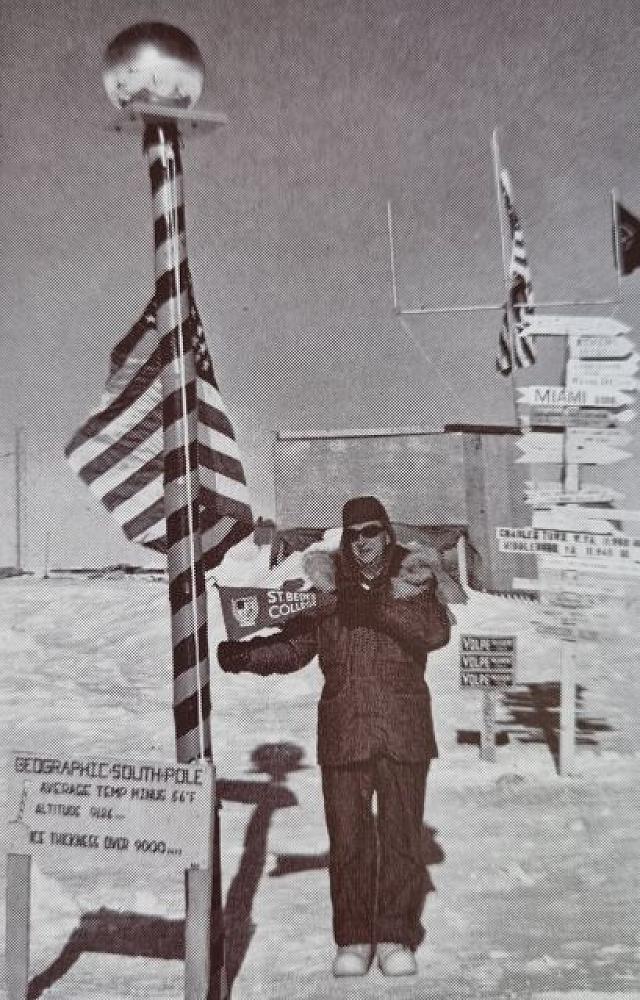
Service in the South Pole
The South Pole holds a fascination for many people.
We have all heard of the race to the Pole by Scott and Amundsen, for Scott it was believed to be a scientific expedition as well as a trek to the Pole, but for Amundsen, a competitive explorer, it was to be who made it first.
While neither Scott or Amundsen could be Old Boys of St Bede’s, we have had teaching staff who have travelled to the South Pole. They were attached to the US Military and received a Service Medal. The Service Medal was as awarded to any Priest who spent a month or more on the continent because the isolation and conditions qualified the continent as a war zone.

This Service Medal turned up on our Archivist’s desk one day and it was through research that we learnt the story behind it.
The following is taken from two accounts of St Bede’s staff members, who were lucky enough to make this journey. The first account is from Fr Spillane and includes about his time on the ice, while the second is from Fr Salamonsen, who went down immediately after, but is about his journey down there by ship.
In 1967, the officer in charge of Naval Operations Deep Freeze, Rear-Admiral Abbot asked Bishop Ashby of Christchurch if he could supply a Chaplain or Chaplains to Antarctica over the Summer months, as the American Chaplain had returned to America and would not be able to return for 12 months.
Not sure quite how or why he was selected, Bishop Ashby had asked Fr Evatt, if a Father from St Bede’s could go, Fr Spillane, a teacher of St Bede’s at the time, was suddenly asked one Saturday night in November if he would “Like to go to Antarctica, as chaplain to the American forces” His answer to this was “I am not capable of handling a dog team”. He was told to think about it over the weekend and give his answer on Monday.
Like most men, as a boy, Fr Spillane had read about the adventures down at the South Pole, but never dreamt that he could one day be there himself. On December 18, he reported to the American base at Harewood and was kitted out for his trip. The amount of clothing that he was supplied with was enough to fill the back of his car and he had to sign a form that if he lost any of it, he would be subject to disciplinary action!
On Friday 22 December, he arrived at Christchurch airport, with all the gear that he would need, there were also 29 other passengers and 6000 pounds of Christmas mail on the flight. The flight, on a Super Constellation took off, but four hours later they were back as the plane was having compass trouble. Back at the Christchurch airport they had to wait until 1am, before they could take off again. On December 23, at 10.30am, they arrived at Williams Airfield, on an ice runway, which was especially for the planes with wheels, the other runway was for the Hercules, planes that landed on skis.
Once at McMurdo, only a 6-mile bus journey from the landing strip, Fr Spillane likened it to an old mining town form the 1860s. He went on to say that although the living quarters were not home away from home, they were all made “fit for male human habitation!” Everywhere was kept neat and tidy and although it was a military base, after a few days there, you are more conscious of the scientific effort that was being put in “The Navy with its hundreds of men, its ships, its aero planes, helicopters and its annual budget of millions of dollars is there to support and make possible the scientific programme.”
Fr Spillane went on to explain about Antarctica, how it is the greatest Desert on Earth, with a snowfall that has the water equivalent of only 4 inches, which at the time was less than the Sahara Desert, although that has now changed, with the Sahara getting less and Antarctica slightly more at 6.5 inches. He was particularly interested in the team responsible for operating a drill which was boring into the ice cap. He was there on three occasions when they brought up samples and on the last time, the geologist with the team placed in his hands “a sliver of ice that had fallen as snow and been pressurized to ice in the year 16 000 BC”. These samples were wrapped in cellophane and placed in aluminium containers to be sent as refrigerated cargo back to America.
Fr Spillane was down to the ice in Summer and so after Midnight Mass at 1am, he walked out of the Church into brilliant sunshine “I walked down to the edge of the ice shelf. The sun shone in a clear sky and it was impossible to look upon the dazzling view without the aid of dark glasses.”

While in Antarctica, he was able to visit the original huts of Scott and Shackleton. The first hut built by Scott is only a 10-minute walk from McMurdo.

Scott’s second hut built for the 1911-1912 expedition was a helicopter ride away. Fr Spillane was lucky enough to be taken to this hut, where he could actually hold packets and tins of food that were left, look at a newspaper from 1909 and hold goods and equipment the men and animals had used, which have all been preserved on the shelves because of the cold. As Fr Spillane and the crew were getting ready to leave the hut, it began to snow and although they took off, the heliport was closed and they had to turn back and wait through the night at an emergency building. Fr Spillane went back to Scott’s hut in the early hours of the morning and he says the following:
“The silence inside was absolute, and outside there was nothing but the slow lap of the sluggish Antarctic tide on snow covered sand.” This he said is a memory he will never forget.

Fr Salamonsen was to follow Fr Spillane down to the ice, but rather than flying down on a Constellation, Fr Salamonsen went down by ship. They left Lyttelton on January 4, sailing on the HMNZS Endeavour, a NZ Navy Antarctic Supply Ship, which was first launched as the USS Namakagon, to sail through “Latitudes that lead to the bottom of the world; and mariners agree that no seas are rougher”.

To travel down by ship, was to see “the growing length of the days, the first iceberg and the first lone killer whale”. The wind that blew from the South East brought an ever-increasing chill to the air.
As they neared their destination, “The first towering tabular icebergs were sighted-great slabs off the Ross Sea ice shelf, often over 100ft in height (and remember only one seventh appears above the sea)”. Packs of killer whales would swim past, seals would yawn and penguins would take to the water.
They rendezvoused with the ice breaker Westwind, in a “becalmed white sea” and then carried on down through the Ross Sea, once again on Endeavour.

Finally, “we made our landfall. The steaming peak of Erebus with glaciers sliding down its slopes loomed on our port bow, and familiar illustrations from Antarctica books took on a real dimension. There was Observation Hill, Scott’s expedition hut and the shelter of McMurdo Sound…McMurdo was American-hospitality, was relaxed and warm, Coca-Cola was canned and traffic sludged on the right-hand side of snow banked roads”.
For Fr Salamonsen, the memories of holding Mass on a heaving deck will always remain as will the colour and vastness of Antarctica.
For both of these men, Antarctica will be an experience they will never forget and while the living conditions from Scott’s time to 1967 and from 1967 to now have changed, we all still know what a special place this continent is. Although the services of Catholic Priests to Antarctica have now come to an end, with a combination of cost cutting and falling demand, Fr Dan Doyle, the last Kiwi Priest said “We are really sad…After 60 years of ministry at the end of the Earth-a great challenge in an amazing place-to be told that we’re not needed anymore…it’s a bit sad.”
Gallery



